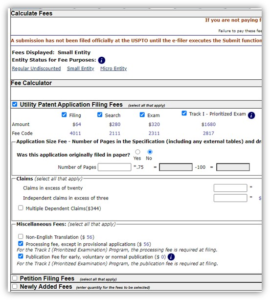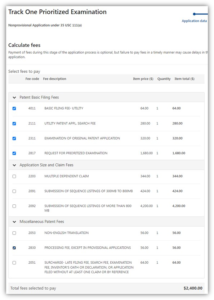One of the expressly stated goals for the USPTO developers developing Patentcenter is that every feature and function of EFS-Web and Private PAIR be carried forward into Patentcenter. Only after this has been accomplished would it be acceptable for the USPTO to pull the plug on EFS-Web or Private PAIR. Unfortunately, users of Patentcenter frequently encounter situations where some feature of EFS-Web or Private PAIR has been only incompletely carried forward. This article describes a failure of the developers to fully carry forward all of the features of the Track I workflow. This harms applicants, as I will describe in some detail.
The background for this blog article is Track I. This is the track in which an applicant pays a lot of extra money to the USPTO, and the USPTO undertakes to accelerate the processing of the application so that everything is completed within a year. (This might mean a Notice of Allowance or it might mean a final rejection.)
Perhaps understandably, the rules for Track I provide that the filer is required to get just about everything right about the filing, on the first try. If the filer gets something wrong about the filing of the Track I application, then the usual result is that the application will never be placed on Track I. There is no second chance for the details of requesting Track I status, other than to remedy certain small details in the request that are not relevant to this discussion about fees.
When filing a Track-I application, there are two fees beyond the standard fees that are due for any other nonprovisional application: the Track-I fee ($1680 for a small entity) and a miscellaneous fee ($56 for a small entity). Both of these fees are due at the time of filing. If you fail to pay the miscellaneous fee, the Track-I request is denied and there is no mechanism to resuscitate the Track-I request. (The filer who wants to try to get the case onto Track I after failing to pay that fee could salvage things by filing an RCE and perfecting the Track-I request in the RCE. This is, of course, prodigiously expensive.)

EFS-Web handling of Track-I filings. The designers of EFS-Web did the right thing about the fees. When filing a Track-I application in EFS-Web, the “Track I – Prioritized Exam” fee is prominently displayed. Clicking on the checkbox for the Track I fee generates a reminder of the other fees due, as shown at right.

More importantly, EFS helpfully notes in italicized language that the “Processing fee, except in provisional applications” is relevant to Track I. You can see this in the screen shot at right.
Patentcenter handling of Track-I filings. As mentioned above, if the Patentcenter developers had done their job correctly, they would have noted these features of EFS-Web and they would have put them on some kind of feature list to make sure that the features got reproduced in Patentcenter. But instead, one suspects, the only thing the Patentcenter developers entered on their feature list was “provide a click path that has the possibility of leading to a perfected Track-I filing”.

What Patentcenter really does about fees in a Track-I filing is a great disappointment. Patentcenter lulls the filer into a sense of complacency by prominently emphasizing the “REQUEST FOR PRIORITIZED EXAMINATION” fee into the main Patent Basic Filing Fees group, while allowing the “PROCESSING FEE, EXCEPT IN PROVISIONAL APPLICATIONS” to languish unnoticed under a fee category called “Miscellaneous”. See the screenshot at right.
The fee calculation screen shown at right is specific to Track-I filings (see the page header of “Track One Prioritized Examination”). But there is no Track-I filing scenario in which the filer would only want to pay one of the two Track One fees. So what ought to have happened in this fee calculation page is that the “PROCESSING FEE, EXCEPT IN PROVISIONAL APPLICATIONS” should have been presented up in the main Patent Basic Filing Fees group. Perhaps even easier, almost as helpful, and not mutually exclusive would be to add a parenthetical to the fee.
What the alert reader will instantly appreciate is that this is a situation where the USPTO developers ought to have provided a simple validation — if the filing is a Track-I filing, and if somehow the filer reaches the “submit” page without having selected both of the required fees, a warning ought to appear. This is the sort of things computers are good at!
What probably happened here during the coding of this part of Patentcenter is, somebody worked out that if the filer happens to somehow avoid forgetting or overlooking any of the required elements for Track I, then this workflow path in Patentcenter will just barely count as a workflow that gets an application onto Track I. This then (wrongly) prompted the developer to check off the “let’s make a Track-I workflow” item on the to-do list. What should have been on the to-do list was “let’s make a Track-I workflow in Patentcenter that provides all of the reminders that are provided in the Track-I workflow in EFS-Web”. If that had been the wording of the item, then even now in 2023, it would be wrong to check off that item as having been completed.

I have filed several Track 1 applications for one of my clients, and I always have to double check to make sure I’ve paid both of those fees. You’re right that the PatentCenter developers could have made this much easier. But why stop at just moving things together or failure-checking to make sure both fee boxes are checked? The right answer would be to provide a single box for Track 1 filers that pays both fees. And, for that matter, why shouldn’t PatentCenter make it even easier and automatically check the right fee box(es) by default, anyway?
Yes of course you are right. That’s what WIPO would do in any similar situation in ePCT. They validate things like this and at least they warn you if you are about to make a dumb mistake.
Why are there two fees? It’s a single Track 1 request, why doesn’t the PTO just bundle this in a single fee?
And if you pay the big fee but forget to pay the small fee and they bounce the Track 1 request, can you get the big fee back?
It takes a lot of chutzpa for the PTO to produce something as bad as patentcenter, then ask for people to volunteer their time to give feedback, and then for years ignore the input it gets from those volunteers.
Dan, that’s an excellent question. With reference to the undiscounted fees, why do you have to pay the USPTO $140 in order to entice them to take your $4200? Why can’t it just be a $4340 fee? There is probably some internal accounting reason about the different buckets those fees get allocated to, but it sure is a silly dichotomy to an outside observer.
According to the USPTO’s Prioritized Examination FAQ, they automatically refund the big fee if the Track One request is rejected.
And that’s probably why there are two fees. They have to refund the big fee, but get to keep the “processing” fee even if they reject the Track 1 request. If they combined the fees into one, they couldn’t do that.